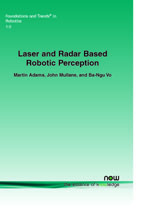Laser and Radar Based Robotic Perception
By Martin Adams, Dept. Electrical Engineering, University of Chile, Chile, martin@ing.uchile.cl | John Mullane, School of Electrical & Electronic Engineering, Nanyang Technological University, Singapore, jsmullane@ntu.edu.sg | Ba-Ngu Vo, School of Electrical, Electronic & Computer Engineering, University of Western Australia, Australia, ba-ngu.vo@uwa.edu.au
Abstract
Perceptive laser and radar sensors provide information from the surrounding environment and are a critical aspect of many robotics applications. These sensors are generally subject to many sources of uncertainty, namely detection and data association uncertainty, spurious measurements, biases as well as measurement noise. To deal with such uncertainty, probabilistic methods are most widely adopted. These probabilistic environmental representations, for autonomous navigation frameworks with uncertain measurements, can generally be subdivided into two main categories — grid based (GB) and feature based (FB). GB approaches are popular for robotic exploration, obstacle avoidance and path planning, whereas FB maps, with their reduced dimensionality, are primarily used for large scale robotic navigation and simultaneous localization and map building (SLAM). While researchers commonly distinguish both approaches based on their environmental representations, this paper examines the fundamental, theoretical aspects of the estimation theoretic algorithms for both approaches. Emphasis on the measurement likelihoods is used to incorporate measurement uncertainty, and their impact on the resulting stochastic formulations is examined.
This paper also explores the front-ends of commonly used laser and radar sensors to develop an in-depth understanding of inherent measurement uncertainty. In this monograph, perceptive uncertainty is largely categorized into that related to signal detection and range measuring. While range noise is commonly addressed in the robotics literature, there is less emphasis placed on detection uncertainty and its subsequent impact on stochastic robotic perception algorithms. As such, following a signal level analysis of both laser and radar range finders, this paper addresses stochastic measurement modeling and map representations. In particular, occupancy grid methods based on spatial statistics are reviewed as well as those more recently based on detection statistics. Recent work, which proposes that the occupancy state space is more appropriately propagated by applying the discrete Bayes recursion using estimates of the detection and false alarm probabilities, as opposed to the commonly used range measurement likelihoods, is discussed.
A review of FB perception methods is presented, with particular attention to the important fields of robotic mapping and SLAM. In particular, comparisons of state-of-the-art Gaussian, Gaussian mixture, and nonparametric map representations are given, demonstrating the assumptions and advantages of each technique. Finally, recent FB frameworks using random finite sets are reviewed in which the measurement model is generalized to include detection uncertainty and the feature map representation is generalized to incorporate uncertainty in the number of features present. These recent developments add a new direction to the well-studied problem of robotic perception and the estimation of any given environment.
Laser and Radar Based Robotic Perception
A crucial component of perception is the understanding of information which has passed through a sensor's detection process. In the world of autonomous robotics this takes the form of sensor understanding and modelling, feature detection, predicting measurements/observations, feature matching and sensor data representation. Laser and Radar Based Robotic Perception presents a review of autonomous robotic perception, exploring recent work from the autonomous robotics and tracking communities in general as well as from the authors' own experiences. Throughout the text, experiments and results are derived from the authors' experiences with laser and radar based sensors. The concepts used in the experiments, and conclusions drawn from them, are then compared with state of the art perception methods in a review type fashion. Laser and Radar Based Robotic Perception also reviews and presents methods which cope probabilistically with missed detections (the possibility of a sensor not detecting an object of interest), object spatial uncertainty (in which detected objects are given uncertain range and/or bearing values due to sensor noise) and false alarms (the possibility of a sensor reporting a detection, due to noise, when in fact nothing (or nothing of interest) is present). Environment measurement models based on these phenomena are therefore analysed. A further concept, often over-looked in the robotic, but apparent in the tracking literature, is that of estimating the correct number of features in an environment. Recent work which advocates the joint estimation of map features with respect to their number as well as location is reviewed.
